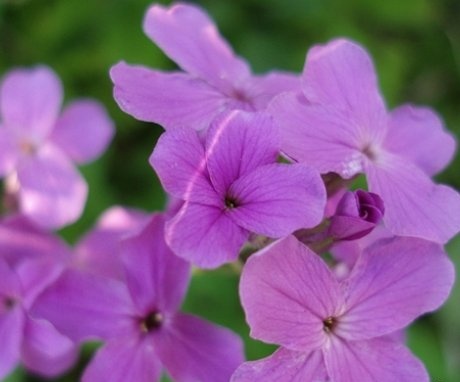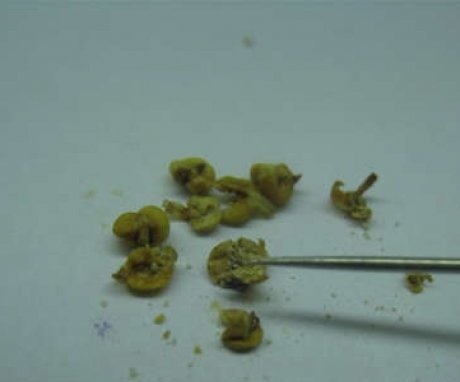Rules for growing night violets
The night violet is a perennial plant that belongs to the cabbage family. It has been known since the XIV century. At home, biennial varieties are more common. Plants have straight stems, the height of which can reach 50 cm.
Content:
- General information about the night violet
- Types of violets
- Flower care and reproduction
- Application
General information about the night violet
Night violet has another name for mattiola two-horned.
It grows on the territory of the European part of Russia, in the Caucasus. Leaves are small, sharp, flowers can be double, but more common are simple. Blooms delicate purple color and has a pleasant aroma. The flowers are collected in small inflorescences in the form of small brushes. The value of this plant for gardeners lies in the fact that flowering begins in the evening and lasts almost all night. The night violet is very similar in appearance to the phlox, which is why it is sometimes called "bovine phlox".
The flowering period takes place in summer, mainly in June and July.
Fruits appear in autumn, these are pods, the length of which is no more than 6 cm. The pods contain seeds, the number of which can be more than 1500 pieces per gram. Seeds can be stored for 2 years and after this period they will still be viable. It tolerates winter well, even without additional insulation. It is very easy to grow, does not require special climatic conditions. Very unpretentious, which attracted the attention of gardeners of the Eurasian continent.
Types of violets
There are many varieties of night violets in nature, but gardeners prefer only a few varieties that are most suitable for home cultivation.
Mattiola Evening scent:
- The plant of this variety has stems with strong branching, the height of which can reach 40 - 45 cm.
- It blooms in a delicate lilac color with beautiful dense inflorescences.
- When in bloom, it emits a delicate, strong aroma.
- This variety is most popular among gardeners due to the delicate color of flowers that open in the evening, and a pleasant aroma.
Mattiola Starlight:
- This Mattiola variety grows up to 50 cm in height.
- Flowers during flowering have a varied color.
- It is highly appreciated by gardeners for its aroma; flowers do not have much beauty.
- It is recommended to sow near benches, near the entrance, under windows.
Mattiola Night Violet:
- This variety is not very tall, the stems grow up to 30 cm in height.
- It blooms with delicate flowers, collected in loose inflorescences.
- During the day, the plant looks wilted and not attractive, therefore, it is better not to plant them in open flower beds and along paths in the garden, their appearance is not attractive.
- And in the evening the plant "wakes up", opens up, its appearance becomes fresh, and the flowers exude a delicate pleasant aroma.
Mattiola Lilac:
- A tall plant variety, the height of the stems can reach 50 cm.
- Leaves are small, coarsely toothed.
- Prefers bright areas for growth.
- The stems are strongly branched.
- Flowers are small, pale purple in color, collected in loose inflorescences.
- Has a pleasant, delicate scent.
Flower care and reproduction
Night violet is an unpretentious plant and does not require special care. But when breeding this plant at home, some care rules should be followed.
Courtship rules:
- It is worth watering the night violet regularly, but in moderation, not more than once a week, especially if the summer is dry.Do not let the soil dry out, but stagnant water is also very harmful to the plant. It is very useful to weed the soil around the plants after watering. The watering process is best done in the morning, and in two stages, for a good passage of water into the depth of the soil.
- It is worth feeding the plant no more than 2 times a month with mineral fertilizers.
- The night violet is very fond of humid air, but even at low humidity, it feels great and this does not affect flowering in any way. It adjoins well with any plants, although it grows well.
For the winter, the plant does not need to be insulated, the night violet tolerates cold winters well.
Reproduction by seeds:
- You can buy seeds of the Night Violet in almost any store for gardeners and florists.
- To plant seeds, they must be mixed with sand. The open field sowing period is late April if the weather is warm, or early May if April is cold.
- Planting depth should be minimum, a very good percentage of germination, if the seeds are sown on top of the ground and sprinkle with 0.5 cm of soil.
- The distance between crops should be at least 10 cm.
- The landing site must be chosen light or in partial shade, and in order to subsequently enjoy the aroma of the Night Violet, sowing is worth near the gazebo or bench.
It is not recommended to grow Night Violets for seedlings, and then plant them in open ground.
She does not tolerate transplanting and as a result, only 20% of the plants can grow. But if the plants were sown outdoors in different places on their own, as a result of the flowering of the plant in the previous year, then it is recommended to transplant it into a flower bed together with a lump of earth in which the flower grows. The soil for planting Night Violets should be moist and loose.
It can be slightly fertilized, only without organic matter, and water should not linger in it. Poorly tolerates acidic soils. The flowering of the plant begins after 1.5–2 months after planting. To prolong the flowering of plants, after the first planting, after a week you can sow some more seeds, and after another one - the next batch. Thus, the Night Violet can be enjoyed until mid-autumn.
With proper care of the Night Violet, it becomes very resistant to diseases and pests.
But sometimes the plant can be attacked by such pests as cruciferous fleas, whites and, most often found, caterpillars of cabbage butterflies. To remove all of these insects, there are many products available on the shelves of horticultural stores.
Application
Night violet planted near the house or gazebo, in order to enjoy the pleasant smell of this plant every evening throughout the summer. Also, a night violet can be planted on a loggia or on a balcony, it will grow beautifully even in such conditions.
This plant is often used for medicinal purposes:
- For example, many useful substances and ingredients can be obtained from seeds for adding to medicines.
- Often in medicine, this plant is used as a diuretic.
- The leaves of the Night Violet contain essential oils.
- There are many recipes for making an alcohol-based leaf extract. The resulting medicine will have antibacterial properties.
Also, the seeds and leaves are infused together:
- The resulting tincture is good for rheumatism and gout. To prepare such a medicine, you need to take 0.5 teaspoon of seeds and a teaspoon of the plant. Pour boiling water over this mixture, about 0.5 liters, leave for 2 hours. This drug is used 3-4 times a day, 100 ml. But you should be very careful with this plant, as it has poisonous properties. If the dosage is incorrect, you can get poisoning.
For harvesting the Night Violet, the period is chosen from the end of spring to the beginning of summer, at this time the grass is collected for its subsequent drying, the seeds are harvested when the fruits of this plant ripen, that is, in the fall.
There is also another application for seeds that has recently become fashionable. They are germinated for later use in salads or for separate food use. Sprouts contain a large amount of vitamins A and C, as well as phosphorus, magnesium, and iron. Seed sprouts stimulate appetite and stimulate the restorative functions of the body.
So plants Night violet brings not only aesthetic pleasure, but can be used as aromatherapy at home, when planting it on your site or on the balcony, or a medicinal herb that will help in some diseases.
More information can be found in the video.
















